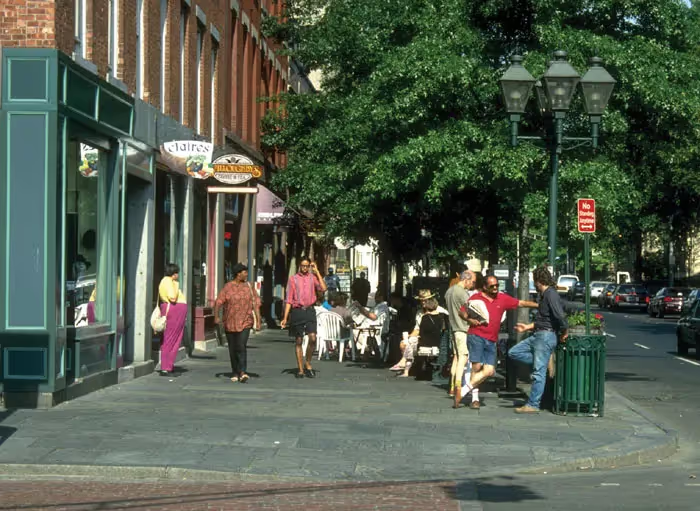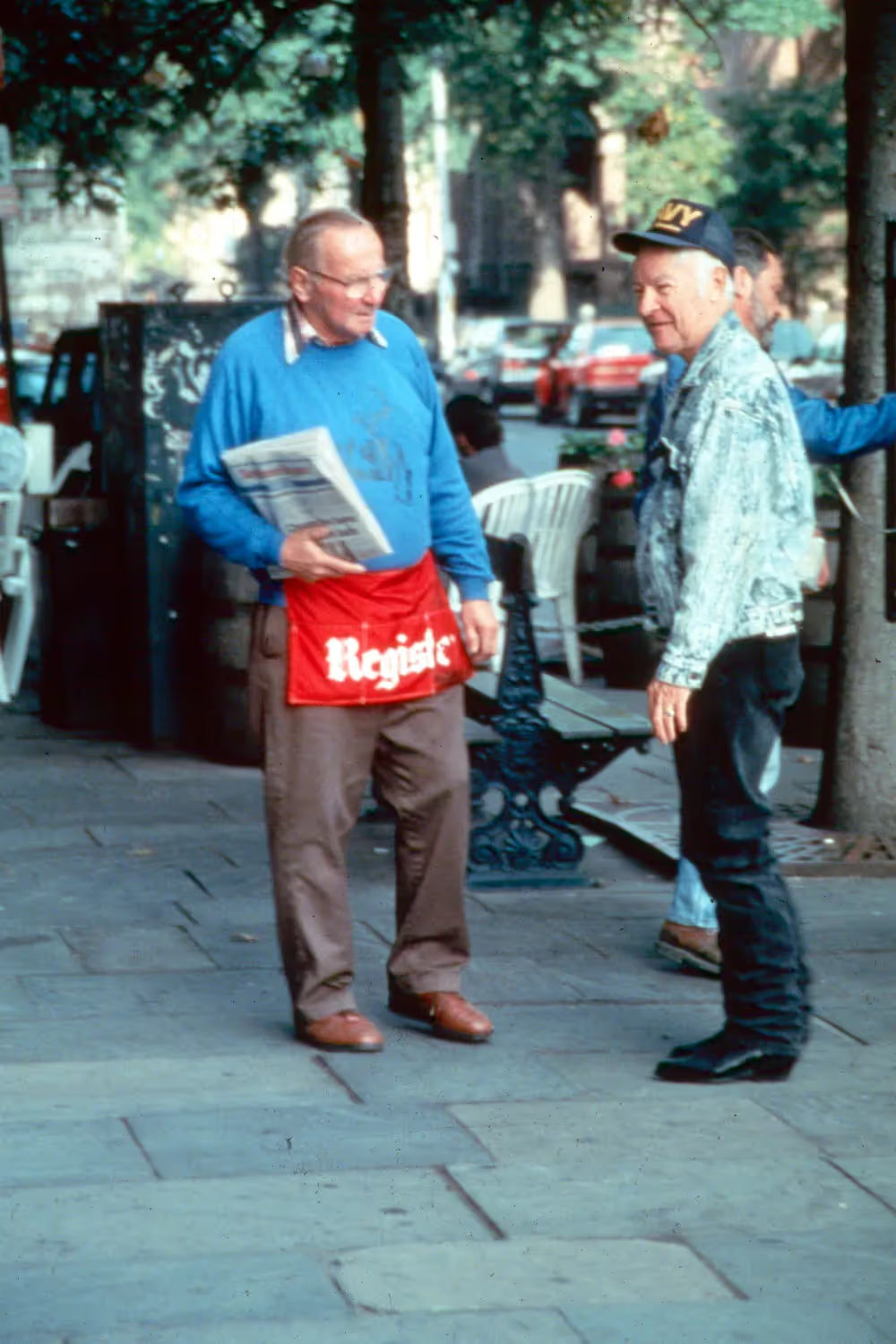A biweekly newsletter with public space news, resources, and opportunities.
A curated dispatch on all things public markets plus the latest announcements from the Market Cities Program.
Please note that these Hall of Shame nominations were written in a moment in time (most over a decade ago) and likely have since changed or even been transformed. If the above entry is now great, or still not so great, go ahead and comment below on how it has evolved or nominate it as a great place.

Two streets that split their real estate equally between Yale University and local merchants.

The College/Chapel District is a few exceptional blocks of downtown vitality in a small city that needs a reminder that such a thing exists -- and can be so good. The area is across the street from Yale University, but until its turnaround, a world away. It includes some historic apartment and office buildings, along with the three theaters which have been important testing grounds for Broadway shows. The theaters and the neighborhood went into a tailspin along with the rest of downtown New Haven. With extensive renovation, careful retail leasing, and major sidewalk enhancements, the area has been transformed and now has an active street life.
The inherent qualities of these blocks -- their theaters, historic, multi-story buildings, and proximity to Yale -- made them ripe for renewal as a real mixed-use neighborhood. When Schiavone Realty and Development bought the buildings in the early 1980's they were almost entirely vacant, the city was a mess, and a shorter outlook or none at all couldÍve been expected. Schiavone saw the potential of renovated theaters to act as anchors for new restaurants and shops, and the flourishing of a downtown neighborhood, not simply a "theater district," and has stuck with making it happen; the developer's broad vision and long-term commitment have been crucial to the precipitaion of this great place.
Single ownership and management of most of the area has also been a big asset. The City, benefiting from such a strong private development plan, has been very supportive. This support meant help through the codes for historic buildings, and the contribution of local streetscape enhancements. Schiavone's ability to centrally manage and lease the area has allowed for a careful integration of old and new tenants and an over-all high quality. Tenants' fees pay for a full-time maintenance crew. Security guards were discussed, but activity on the street has made the area very safe.
The streetscape improvements, funded by the city and planned with the help of Project for Public Spaces, have been another important component of success. Widened sidewalks have made room for caf_ tables, curb extensions favor pedestrians, and the whole suite of trees, baskets, and bricks gives the area a strong and welcoming identity. The College/Chapel area has broken the seal between privileged Yale and the city at its doorstep.
Until the early 1960's, the College/Chapel area was the most successful part of New Haven, with offices and residents, restaurants and shops, and several theaters used as "try-outs" for Broadway-bound shows. Like so many American cities, New Haven suffered in the following decades. By the early 1980's, the buildings in the district were 95% vacant, including the historic Taft building and the Palace Theater. A single-room-occupancy hotel on one corner housed the remaining residents.
Believing that the area could be brought back to life, Schiavone Realty and Development embarked on an unusual endeavor by privately financing the purchase of buildings and taking on the full responsibility of rehabilitation, leasing, and public space management. Although it was hoped that the refurbished theaters would help revive the city's cultural life, the project was not conceived as a theater district, but as an active downtown neighborhood.
Development work, which largely entailed the renovation of old and historic structures, began in 1982 and continued through 1984. New Haven chipped in significant streetscape improvements in 1983, with planning guidance from Project for Public Spaces. These improvements involved widening the sidewalks by three feet on College and one foot the side streets, building five-foot curb extensions into Chapel and Crown, and replacing two of the four lanes of traffic on College Street with parallel parking. Brick pavers were installed in the crosswalks and along the perimeters of sidewalks, and trees, benches, bike racks, trash bins, special lighting, plantings, and public art were all introduced.
Schiavone retained ownership and management of all of the residential and commercial uses in the buildings. Breaking from convention, the developer worked to ensure that existing tenants, including a cigar store and a health food restaurant, stayed through the renovation. Schiavone has continued to favor locally-owned stores and resist chain stores, although a few like The Gap are now anchor tenants.
The College/Chapel District today is a heavily-frequented, mixed-use area that includes 400 residential units, 55 retailers and restaurants and 100 commercial tenants in upper level offices. The 25 restaurants within and around the Schiavone property make the area a big destination for dining out. Three cafes with outdoor seating cluster around the corner of College and Chapel, accompanied by three clothing stores, a jeweler, and a newsstand. In the late hours, activity shifts toward Crown Street and its six nightclubs. Three theaters magnetize the area, as was hoped. The Shubert and the Palace have been completely rehabilitated by Schiavone. At present, the owner manages the Palace and its schedule of entertainments; the Shubert is leased to the city and managed by the non-profit Shubert Performing Arts Center, and presents Broadway shows, opera, dance, musical concerts and family entertainment. The Loew's Poli is vacant and in derelict condition and likely to be demolished and replaced with a hotel; but the lights are on and thereÍs much to be seen at the Yale Repertory Theater nearby.
Tenants' fees pay for a full-time maintenance crew, which has been important at keeping the area spruced up, not worn down. The city operates a parking garage which pre-dates the redevelopment. Police maintain a presence in the area, but there have been no problems with crime.
The costs and difficulties of renovating historic buildings and developing a cost-effective management and maintenance program have made profits a long time in coming; public financial assistance would have improved project economics from the beginning. Still, the project has been an absolute success: 95% of previously vacant retail space is rented for $25 per square foot, empty sidewalks have crowds, people ride bikes in the street, theater happens.



*Please note that these Hall of Shame nominations were written in a moment in time (most over a decade ago) and likely have since changed or even been transformed. If the above entry is now great, or still not so great, go ahead and comment below on how it has evolved or nominate it as a great place.